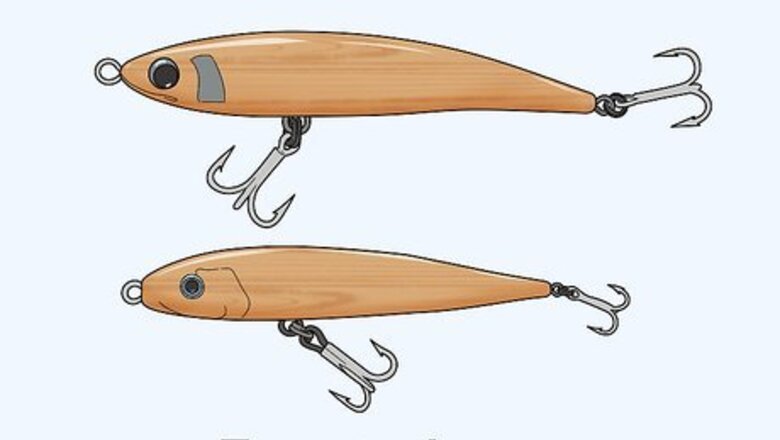
views
Designing Your Lure
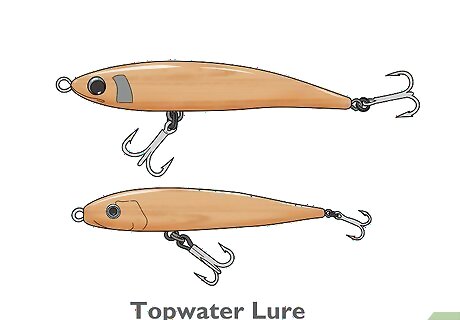
Make a topwater lure if you wish to catch fish near the water’s surface. Topwater lures are lightweight and tend to move around a lot. They are typically the simplest kind of lure to make since you don’t have to worry about getting them to sink to a certain depth. They work best during early morning and evening hours when fish are most active. However, their coloring matters a lot since they need to stand out to the fish below them. Poppers have a depression in the front that looks like an open mouth. Water resistance causes a popping sound when it is jerked across the surface, which makes the lure to resemble struggling bait. Stick baits, also known as torpedo lures, are cigar-shaped and lightly weighted at the rear. When you jerk the lure forward, it resembles a wounded catfish. Propeller baits look similar to stick bait but have 1 or more bladed propellers on the end. When the lure is pulled in a jerking motion, the splash and vibration from the propellers attracts fish. Splutterbaits have metal plates on the front or sides to create resistance and sway.
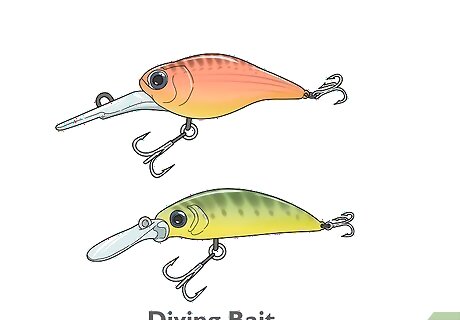
Create a diving bait if you want to catch fish in deeper water. Diving baits usually feature a lip that causes them to sink when retrieved. That means they require a little more caution when making, although carving the lip doesn’t require much extra work. A lip is like a duckbill curved downward on the end of the lure and is responsible for it sinking in the water. These lures have to be stronger and a little heavier than topwater lures in order to hold up, but they can be used at any time of the day in any kind of water. Plugs are solid, rounded lures that usually include a lip enabling them to sink. Some varieties have an internal rattle to attract crankbait, which are fish that eat smaller fish. Thin minnows are long, narrow lures that resemble minnows. They have a small diving lip on the front to make them dart around like minnows when retrieved. Curved minnows have no lip. Instead, they have curved bodies with a flat spot on the front that causes them to wobble from side to side. Deep-divers or sinking lures have long lips that enable them to sink when they aren’t being retrieved. They are often shaped like minnows but are used fish in deep water.

Download a template if you want to create a lure from a pattern. Making a lure from scratch can be tough when you’re unfamiliar with how to do it. If you need help getting started, search online for lure templates. You can find patterns for all sorts of different lures. These patterns show you what shape to cut the lure as well as where to install features like hooks. You could also examine store-bought lures or pictures of lures and try to replicate them. Most lures aren’t too complicated and can be made by following the same basic steps.
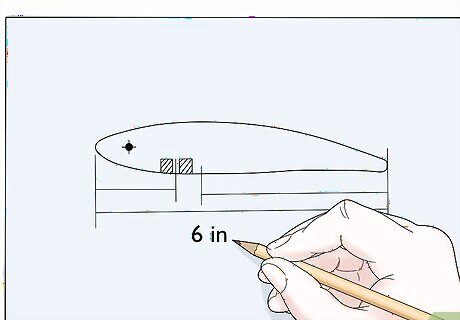
Design a lure over 3 to 6 in (7.6 to 15.2 cm) long for bigger fish. The lure size you use should match the kind of fish you expect to find when you’re out on the water. Standard plugs and crankbait are usually less than 6 in (15 cm) in length but vary in thickness. Plugs for large fish like muskellunge (muskies) can be up to 10 in (25 cm) long. Try looking up a sizing chart online, especially if you’re not using a template, to get an idea of the lures commonly sold and used in fishing. Having a variety of lure sizes helps a lot. That way, you can make adjustments according to your style and what you encounter on the water.
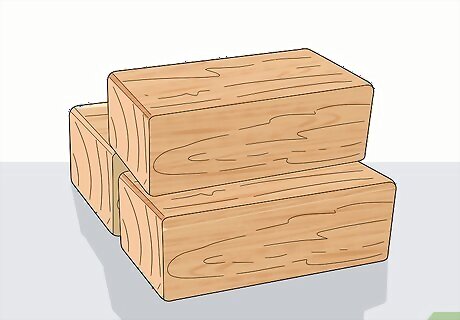
Pick a strong but lightweight piece of wood for the lure. Softwoods such as balsa, cedar, and pine are easy to shape into lures that float. Pick one of these softwoods or basswood for topwater plugs and diving lures that wiggle a lot. Hardwoods such as ash, maple, oak, and walnut are tougher to shape. Save them for lures that hold their depth and don’t move as wildly, such as offshore poppers and stick baits. If you’re unfamiliar with making your own lures, you can’t go wrong by sticking to a safe choice like balsa or pine. The strength of the wood matters a lot. Factor in the kind of fish you’re trying to catch. If you’re catching something big and strong, pick a damage-resistant type of wood to match.
Cutting the Wood to Shape

Purchase wood that is at least ⁄2 in (1.3 cm) bigger than the size of the lure. Figure out the approximate dimensions of the lure before selecting a piece of wood. The wood should be a little bigger than the lure so you have room to carve its shape and sand it flat. If you happen to get one that is much bigger than the lure, cut it down to a smaller size with a saw or carving knife. Home improvement stores and lumber retailers carry all sorts of wood. You may also be able to find some carving blocks at craft supply stores. Most home improvement stores also carry all the other supplies needed to make a lure, although you can also order supplies online.
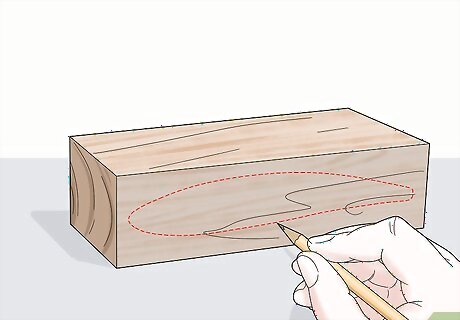
Sketch the shape of the lure on the sides of the wood. If you’re using a template, place the template on the wood and trace around it with a pencil. Otherwise, draw it freehand. Take your time to make sure it matches how you want the finished lure to look. You can usually sketch the outline along one edge of the wood and then cut the lure as a single piece. The outline is what you will follow when trimming the wood into shape. Make sure it is neat and accurate.

Put on a dust mask and protective glasses when cutting wood. Prepare for the dust and fragments kicked up during the cutting process. Put on ear protection as well to deal with loud saws. Consider working outdoors or in a well-ventilated spot to eliminate the amount of debris you have to contend with. Also, keep other people out of the area until you are done. You won’t need all of this gear if you’re using a carving knife. Instead, switch to a pair of damage-resistant carving gloves or thumb guards. Put the dust mask back on while painting the lure to guard against fumes.
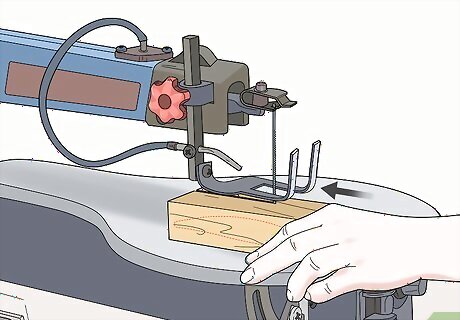
Use a scroll saw or band saw to cut along the pattern lines. While you can use a carving knife at this point, using a saw is much faster. Scroll saws and band saws are made for cutting small, irregular shapes like a lure. Plan on keeping the lure a little bigger than you intend the finished product to be. This will leave you with a little margin of error as you finish it. Try leaving an extra ⁄8 in (0.32 cm) of wood around the pattern so you don’t inadvertently make the lure too small. If you prefer using a carving knife, gradually whittle away the wood around the outline. Move the blade away from your body so you don’t inadvertently cut yourself.
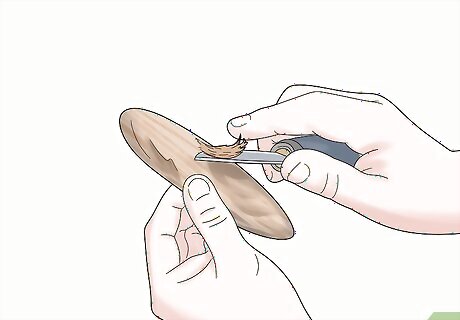
Carve out the shape of the lure with a knife. Now you can begin whittling the lure in earnest. First, make sure the lure is the shape you desire before beginning to create smaller details. Remove the excess wood to round the lure’s body into its intended shape. If you’re making a popper, cut the front end so it curves inward. You can etch patterns and designs into the wood if you wish. It isn’t necessary, but some people enjoy customizing their lures with fins, scales, and other details. To make the groove in a popper lure, try using a rotary tool like a Dremel. It wears away the excess wood, which can be easier than trying to cut the shape.
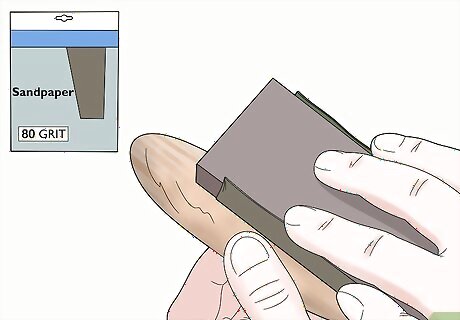
Sand down the wood with 80-grit sandpaper. Once you have created the lure’s approximate shape, refine it with sandpaper. Rub the entire lure with firm, consistent pressure, but pay particular attention to the rough edges. The front and back edges may still be a little sharp. Smooth them out as much as possible to shape the lure. Double-check that the lure is at the proper size you need. You can sand it to remove any excess wood left over from your initial design. You could also use a tool like a belt sander to more quickly finish the lure. Keep in mind that finishing a small lure with a big belt sander is a little trickier than finishing it by hand, but it is doable.

Finish smoothing out the lure with 120-grit sandpaper. Use fine or very fine-grit sandpaper to remove any remaining rough surfaces or imperfections. Go over the entire lure once again until it’s as smooth and consistent as you desire. If you’re still not satisfied with the finish, treat it again with a higher-grit sandpaper, such as 180-grit. When finishing a lure, always start with the lower-grit sandpaper first. Lower-grit sandpapers are coarser than higher-grit ones.
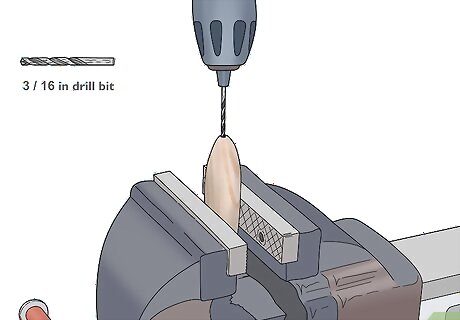
Drill ⁄16 in (0.48 cm) pilot holes for the lead and hooks. Drill directly through the center of the lure’s nose or its groove if you’re making a popper. Turn the lure around and make a second hole through the back end. Then, flip the lure over so its bottom edge is face up. Drill a hole about ⅓ of the way from the front end. Refer to your template when positioning the pilot holes. They can vary depending on the type of lure you are making. Most lures have at least 2 hooks. Plan on putting one on the back end and another near the front. If your lure is long, consider making another hole ⅓ of the way from the back end for an additional hook. If you wish to add weight to the lure, such as for a sinking lure, drill additional holes as needed. Many times, you can drill about ⅓ of the way from the end and fill it with weight later.
Painting the Lure
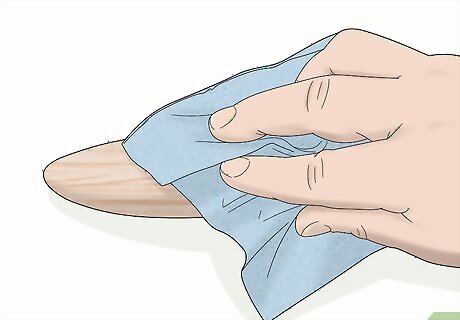
Wipe the lure clean with a tack cloth. The lure will most likely have some wood dust on it. This debris can get in the way of the paint and prevent it from bonding properly. Clear off the entire piece and plan on painting it right away before more dust settles on it. If you don’t have a tack cloth, get a microfiber cloth instead. Lightly dampen it in lukewarm water before using it.
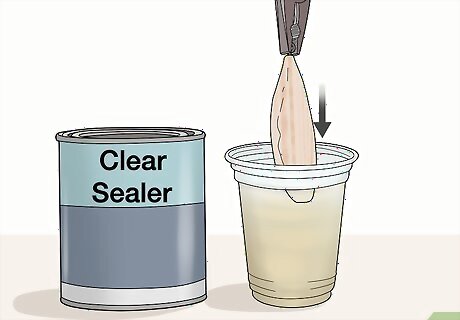
Apply a clear sealer to the lure to prepare it for painting. Select a clear product, such as an epoxy sealer, you can use as a base coat. Spread it over the entire lure in a thin but consistent layer. The easiest way to do this is by dipping the entire lure in the sealer and then hanging it to dry. The sealer prepares the wood for paint and also protects it from water damage. Put a hook into one of the pilot holes you drilled so you can dip the lure and hang it to dry. If dipping the lure isn’t an option, you could also paint it by hand. Wait for it to dry before flipping it over and finishing the other side. This sealer layer isn’t the same as the one you add after painting the lure. Apply both to better safeguard the lure against damage.
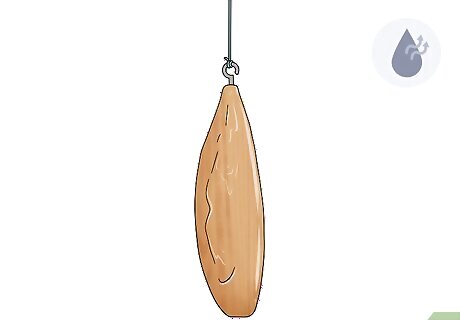
Wait about 20 minutes for the sealer to dry. If you use a quick drying primer, it can save you a lot of time. The exact drying time required varies depending on the product used, so check the manufacturer’s recommendation. Check that the lure is dry to the touch before attempting to paint over it.
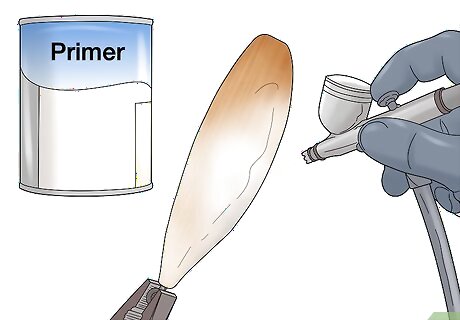
Apply a base coat of primer to the lure with an airbrush. Match the primer to the kind of paint and sealer you are using. Try using a water-based acrylic primer. The quickest way to get a good finish is by dipping the lure into the primer. You could also load the primer into an airbrush and spray it on. Select a white primer to create a good base to paint over. Other primer colors may be too dark for an effective lure. Keep in mind that some sealers also serve as a primer, so you won’t have to use a separate primer. If you’re uncertain, apply primer so that you can be sure the paint bonds to the wood.
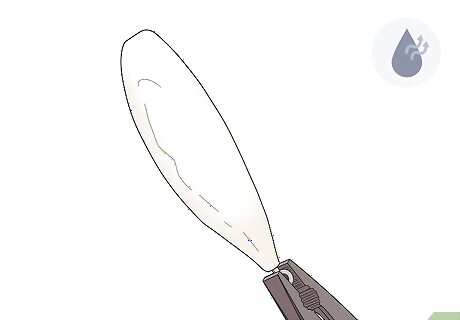
Let the primer dry for about 30 minutes. Note the manufacturer’s recommendation on how long the primer needs to dry. It can vary, but it usually doesn’t take too long. Make sure the primer feels dry to the touch and has had enough time to fully cure before moving on. You may wish to even out the initial coating by applying a second layer of primer. It isn’t necessary, but it’s a good way to correct inconsistencies.
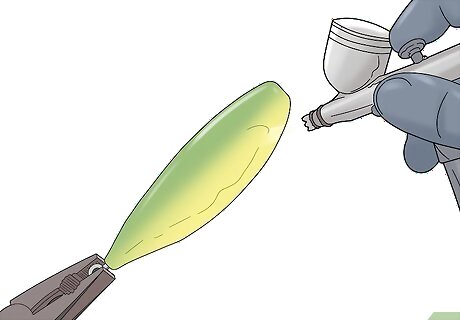
Paint the base layers of the lure first with a brush or airbrush. Acrylics come in all sorts of different colors, so plan out how you want the finished lure to look. For visibility, select bright, vibrant colors that stand out against the sky. Apply the underlying and lighter colors first. Paint them on by moving across the lure in slow but consistent strokes. Most people use an airbrush for a professional-looking finish. Using a brush or spray paint is fine, but it may take longer. For ideas about how to paint a lure, look at a fishing lure catalogue. Lures come in all sorts of styles, but the best ones tend to look bright but natural, like small fish or insects. The right color for your lure will partly depend on where you plan on fishing with it. For example, saltwater lures are usually bright colors to attract fish, while freshwater lures are muted colors so they don't scare fish away.
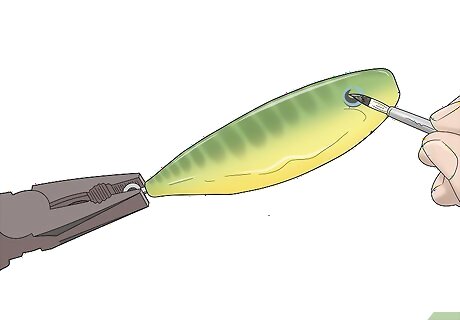
Add any details you wish to paint onto the lure. This includes darker colorings as well as features like eyes. Apply the darker paint over the base layer once it has dried. Make the lure look as realistic as possible so that fish chase after it. For example, you might keep the bottom half of the lure white and then paint the top half dark blue. Another option is to paint some darker stripes down a yellow lure.
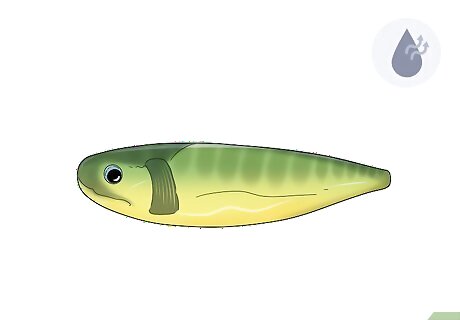
Wait about 30 minutes for the paint to dry before finishing the lure. Let the paint fully cure according to the manufacturer’s recommendations. The lure should feel dry to the touch. Then, look it over to see if it needs any additional work. Touch up spots that don’t look the way you want. You may need to do this several times before you’re done. Wait for each layer to dry before painting over it.
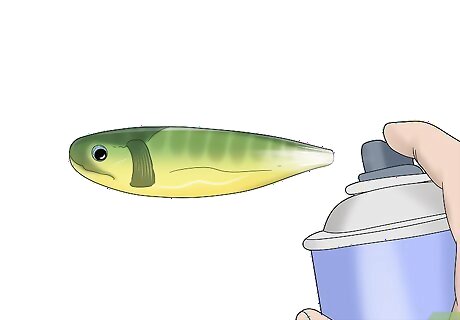
Add an epoxy clear coat to waterproof the lure. Epoxy is easy to work with and is resistant to cracking and staining. It comes as a spray or a liquid to apply with a brush or sprayer. Make sure the entire lure is well-covered in a consistent layer of epoxy. Polyurethane is another finisher you can use. Try getting a variety used on wood floors or automobiles.
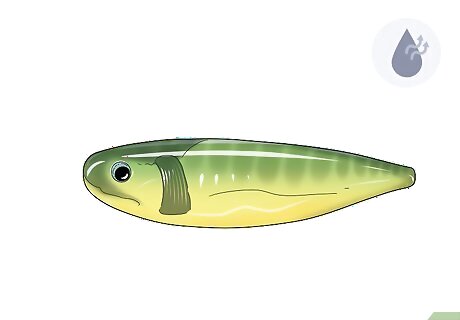
Let the clear coat dry for at least 1 day. You are almost done, so don’t let the wait stop you now. Give the epoxy plenty of time to cure before attempting to use the lure. Leave it to dry in the open in an area with plenty of air circulation. You may need to wait an extra day before handling the lure, depending on the manufacturer’s recommendation. Consider adding a second clear coat layer to ensure that water can’t damage the lure.
Attaching Hooks and Weights

Screw ⁄4 in (0.64 cm) screw eyes into the pilot holes. Pick closed screw eyes, which are basically screws with a hanging loop on one end. Put the threaded ends into the holes you made, then twist the screws clockwise by hand. Continue doing this until the base of the loop is about level with the wood. No matter what kind of lure you’re making, the screws should always be slightly wider than the pilot holes. This helps them stick in place. You can change the screw size according to your lure. If you’re making a big lure, you may wish to use bigger screws for additional strength.
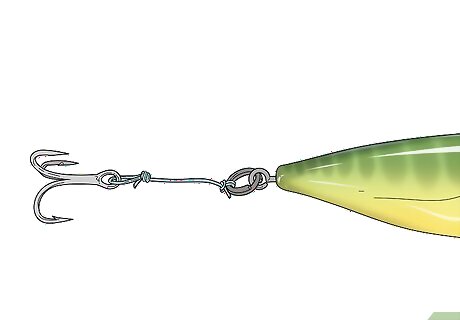
Attach hooks to the screw eyes using split rings. Thread a treble hook onto one end of each split ring. Afterward, thread the split rings onto the rear and bottom screw eyes. You can use split-ring pliers to pull open the split rings when connecting them to the hooks and screws. Split rings are basically open coils. They are often used for keyrings, so look at your house keys for an example of how they work! You could also attach the hooks without using split rings by pulling open their eyelets with a pair of pliers. Be careful to avoid puncturing your fingers if you choose to do this. Although treble hooks are most commonly used on plugs and crankbaits, you could use double hooks instead. Most are designed to slip onto the screw eyes without using split rings.
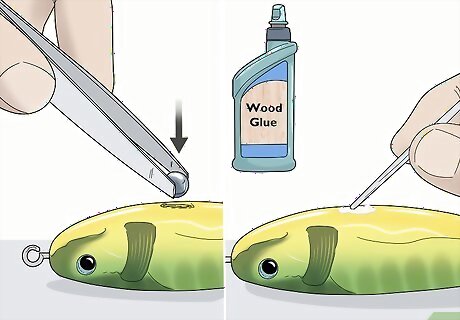
Fill the lure with ballast if you need to add weight to it. If you’re planning on making something like a sinking lure, you should have an unfilled pilot hole still. Pour BB ammo, buckshot, or small split shot into the hole. Then, fill it up with wood glue or a waterproof putty. Make sure the hole is well-sealed. There are many different types of items you can get to weight down the lure. You could buy a sinker weight from a fishing supply shop, for example, and place it inside the lure.

Cut a slot and glue the lip to the lure if you are installing one. Use a carving knife to notch a slot horizontally across the nose of the lure. Diving lips are often little more than pieces of plastic. You can spread an epoxy glue across the slot, then slide the plastic lip into it. Give it at least an hour to cure before using the lure. Angle the notch so the lip will point downward after you plug it in. This will cause the lure to sink when it’s in the water. For most lures, the lip is positioned underneath the ring used for the lead. You could also drill through the center of the lip and then add the ring to it.




















Comments
0 comment